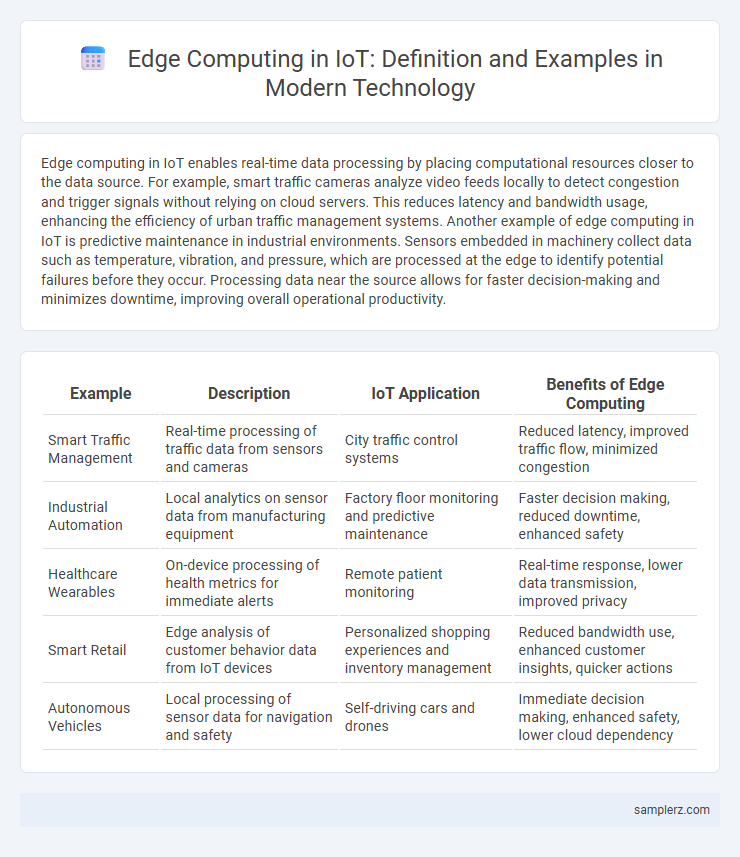Edge computing in IoT enables real-time data processing by placing computational resources closer to the data source. For example, smart traffic cameras analyze video feeds locally to detect congestion and trigger signals without relying on cloud servers. This reduces latency and bandwidth usage, enhancing the efficiency of urban traffic management systems. Another example of edge computing in IoT is predictive maintenance in industrial environments. Sensors embedded in machinery collect data such as temperature, vibration, and pressure, which are processed at the edge to identify potential failures before they occur. Processing data near the source allows for faster decision-making and minimizes downtime, improving overall operational productivity.
Table of Comparison
| Example | Description | IoT Application | Benefits of Edge Computing |
|---|---|---|---|
| Smart Traffic Management | Real-time processing of traffic data from sensors and cameras | City traffic control systems | Reduced latency, improved traffic flow, minimized congestion |
| Industrial Automation | Local analytics on sensor data from manufacturing equipment | Factory floor monitoring and predictive maintenance | Faster decision making, reduced downtime, enhanced safety |
| Healthcare Wearables | On-device processing of health metrics for immediate alerts | Remote patient monitoring | Real-time response, lower data transmission, improved privacy |
| Smart Retail | Edge analysis of customer behavior data from IoT devices | Personalized shopping experiences and inventory management | Reduced bandwidth use, enhanced customer insights, quicker actions |
| Autonomous Vehicles | Local processing of sensor data for navigation and safety | Self-driving cars and drones | Immediate decision making, enhanced safety, lower cloud dependency |
Smart Factories: Real-Time Production Monitoring
Smart factories utilize edge computing to enable real-time production monitoring by processing data locally on IoT devices such as sensors and controllers within the manufacturing environment. This approach reduces latency and bandwidth usage by analyzing machine performance, detecting anomalies, and triggering immediate corrective actions without relying on centralized cloud servers. Enhanced operational efficiency and minimized downtime result from faster decision-making enabled through edge analytics in smart factory settings.
Intelligent Transportation Systems: Traffic Management
Edge computing enables real-time data processing in Intelligent Transportation Systems by analyzing traffic flow and vehicle patterns at local sensors and edge devices. This reduces latency and network congestion, allowing for immediate adjustments to traffic signals and enhancing overall road safety. Smart traffic lights and connected vehicle systems rely on edge-based AI to optimize traffic management and minimize delays.
Smart Agriculture: Precision Farming Solutions
Edge computing in IoT enables smart agriculture through precision farming solutions by processing data from sensors on soil moisture, temperature, and crop health near the source. This real-time analysis optimizes irrigation, fertilizer application, and pest control, enhancing crop yield and resource efficiency. Deploying edge devices such as drones and edge servers reduces latency and reliance on cloud connectivity, ensuring timely decision-making in dynamic farm environments.
Healthcare Devices: Remote Patient Monitoring
Edge computing significantly enhances remote patient monitoring by processing data from wearable health devices directly at the source, reducing latency and ensuring real-time analytics. Devices such as glucose monitors, heart rate sensors, and oxygen saturation trackers transmit critical information to local edge nodes, enabling faster detection of anomalies and prompt medical responses. This localized data processing minimizes bandwidth usage and enhances the reliability and security of sensitive health data in Internet of Things (IoT) healthcare environments.
Retail Analytics: In-Store Customer Behavior
Edge computing in IoT enhances retail analytics by processing in-store customer behavior data locally on devices such as smart cameras and sensors. This real-time data analysis enables retailers to optimize store layouts, personalize promotions, and manage inventory more efficiently. By minimizing latency and reducing the need for cloud communication, edge computing improves decision-making speed and enhances the overall customer experience in retail environments.
Energy Management: Smart Grid Optimization
Edge computing enhances smart grid optimization in energy management by processing data from IoT sensors located at substations and transformers in real time. This localized data analysis reduces latency and enables rapid fault detection, load balancing, and demand response, improving grid reliability and efficiency. Implementing edge nodes ensures seamless integration with renewable energy sources, optimizing energy distribution and reducing operational costs.
Environmental Monitoring: Disaster Detection Systems
Disaster detection systems leverage edge computing in IoT by processing environmental data locally from sensors measuring air quality, seismic activity, and water levels to provide real-time alerts. This localized computation reduces latency and bandwidth usage, enabling faster response times during emergencies like wildfires, floods, or earthquakes. Edge devices analyze patterns and anomalies on-site, ensuring critical information is delivered directly to responders without relying on centralized cloud processing.
Connected Vehicles: Autonomous Driving Support
Connected vehicles leverage edge computing by processing data from sensors and cameras locally to enable real-time decision-making essential for autonomous driving support. This reduces latency and enhances safety by quickly analyzing road conditions, traffic signals, and obstacles without relying solely on cloud connectivity. Edge computing platforms in vehicles integrate AI algorithms to improve responsiveness and accuracy in navigation, collision avoidance, and adaptive cruise control systems.
Home Automation: Intelligent Security Systems
Intelligent security systems in home automation leverage edge computing to process data locally from IoT sensors, enabling real-time threat detection and response without relying on cloud connectivity. Devices such as smart cameras and motion detectors analyze video feeds and environmental data on-site, reducing latency and bandwidth usage while enhancing privacy. This localized processing ensures faster alerts and more reliable security monitoring for smart homes.
Wearable Technology: Fitness and Health Tracking
Wearable technology in fitness and health tracking uses edge computing to process biometric data locally, enabling real-time heart rate monitoring and activity analysis with minimal latency. Devices like smartwatches and fitness bands analyze sensor inputs on-device, reducing dependence on cloud servers and enhancing data privacy. This approach improves responsiveness and extends battery life by minimizing data transmission to central systems.

example of edge computing in IoT Infographic
 samplerz.com
samplerz.com